
TNU Journal of Science and Technology
230(08): 127 - 136
http://jst.tnu.edu.vn 127 Email: jst@tnu.edu.vn
THE IMPACT OF FOREIGN INVESTMENT ON THE SOCIO-ECONOMIC
DEVELOPMENT OF THAI NGUYEN PROVINCE IN THE PERIOD 2018–2022
Nghiem Van Long1*
TNU - University of Education
ARTICLE INFO
ABSTRACT
Received:
06/3/2025
In the context of economic globalization, investment flows from developed countries to
developing nations have been increasing significantly. This presents a favorable
opportunity for developing countries to leverage their advantages and seize opportunities
to promote domestic socio-economic development. Vietnam, as a developing country in
a dynamically growing economic region, considers foreign investment attraction crucial
for both national and local socio-economic development. By employing methods such
as literature review, statistical analysis, comparison, and data synthesis, this article
focuses on analyzing and assessing the status of investment capital attraction and the
development of foreign-invested enterprises in Thai Nguyen province during the period
2018–2022. Based on this analysis, the study provides a comprehensive evaluation of
both the positive impacts and the existing limitations in attracting foreign investment.
The research findings show that FDI capital and enterprises have significant impacts on
Thai Nguyen’s socio-economic development, including accelerating industrialization
and modernization. However, certain limitations persist, especially in the face of the
challenges posed by economic integration. The findings of this study hold important
implications by providing a holistic view of foreign investment’s impact. They serve as
a foundation for proposing solutions to optimize investment capital utilization, drive
economic breakthroughs, and formulate appropriate policies for the sustainable
attraction and management of foreign capital flows.
Revised:
11/6/2025
Published:
11/6/2025
KEYWORDS
Foreign investment
Capital
Enterprise
Socio-economic
Thai Nguyen
TÁC ĐỘNG CỦA ĐẦU TƯ NƯỚC NGOÀI TỚI SỰ PHÁT TRIỂN KINH TẾ - XÃ HỘI
TỈNH THÁI NGUYÊN TRONG GIAI ĐOẠN 2018 - 2022
Nghiêm Văn Long
Trường Đại học Sư phạm – ĐH Thái Nguyên
THÔNG TIN BÀI BÁO
TÓM TẮT
Ngày nhận bài:
06/3/2025
Trong bối cảnh toàn cầu hóa kinh tế, các dòng đầu tư từ các nước phát triển sang nước
đang phát triển ngày càng nhiều. Đây là điều kiện thuận lợi cho các nước đang phát
triển phát huy tốt các lợi thế, tranh thủ cơ hội để thúc đẩy sự phát triển kinh tế - xã hội
trong nước. Việt Nam là một quốc gia đang phát triển trong khu vực có nền kinh tế
năng động trên thế giới, việc thu hút đầu tư nước ngoài có ý nghĩa lớn đối với sự phát
triển kinh tế - xã hội của cả nước và các địa phương. Bằng việc sử dụng các phương
pháp nghiên cứu tổng quan tài liệu, phương pháp phân tích, so sánh, tổng hợp số liệu
thống kê, bài báo tập trung phân tích, đánh giá thực trạng thu hút nguồn vốn đầu tư và
sự phát triển các doanh nghiệp có vốn đầu tư nước ngoài trên địa bàn tỉnh Thái Nguyên
giai đoạn 2018-2022; từ đó đánh giá tổng thể, toàn diện những tác động tích cực cũng
như những hạn chế còn tồn tại trong việc thu hút đầu tư nước ngoài. Kết quả nghiên
cứu của bài báo cho thấy, vốn đầu tư và các doanh nghiệp FDI có tác động mạnh tới sự
phát triển kinh tế - xã hội tỉnh Thái Nguyên, thúc đẩy quá trình công nghiệp hóa - hiện
đại hóa của địa phương; song cũng tồn tại những hạn chế nhất định trước những tác
động và thách thức của quá trình hội nhập. Nội dung và kết quả nghiên cứu của bài báo
có ý nghĩa quan trọng trong việc chỉ ra một cách tổng thể tác động của đầu tư nước
ngoài. Đây là cơ sở đề xuất một số giải pháp nhằm sử dụng hiệu quả nguồn vốn đầu tư,
tạo sự bứt phá trong quá trình phát triển, đồng thời hoạch định những chính sách phù
hợp để thu hút và kiểm soát dòng vốn một cách bền vững.
Ngày hoàn thiện:
11/6/2025
Ngày đăng:
11/6/2025
TỪ KHÓA
Đầu tư nước ngoài
Vốn
Doanh nghiệp
Kinh tế - xã hội
Thái Nguyên
DOI: https://doi.org/10.34238/tnu-jst.12233
*Email: longnv.geog@tnue.edu.vn

TNU Journal of Science and Technology
230(08): 127 - 136
http://jst.tnu.edu.vn 128 Email: jst@tnu.edu.vn
1. Introduction
Foreign direct investment (FDI) plays a crucial role for countries worldwide. For developing
nations, FDI helps attract capital, facilitates technology transfer, creates employment, and
contributes to economic growth. Meanwhile, for developed countries, FDI enables businesses to
expand their markets, optimize production costs, and enhance global competitiveness. Numerous
studies have analyzed the correlation between FDI and economic growth, as well as the factors
influencing FDI attraction [1] - [3]. According to Lim [1], key determinants of FDI attraction
include market size, infrastructure quality, and economic and political stability. Similarly, Jun [2]
and Nunnenkamp [3] focused on identifying the factors influencing FDI inflows in developing
countries - a group that comprises the majority of nations worldwide today. The Asia-Pacific
region has emerged as one of the world's most dynamic economic centers. Lucas [4] and Ruffin
[5] conducted research on the role of FDI and the factors affecting FDI inflows in this region.
Ruffin [5] highlighted that Asian countries are considered "rising stars" of economic growth, with
their contribution to global output increasing rapidly in recent years. In addition to academic
research, international economic organizations have also published studies and specialized
reports on foreign direct investment. Notable works include the "Benchmark definition of foreign
investment" by the Organisation for Economic Co-operation and Development (OECD) [6]; the
"World investment report: Foreign direct investment and the challenges of development" [7]; and
the "World Investment Report: FDI policies for development – national and international
perspectives" [8].
Vietnam is a developing country progressing rapidly on the path of industrialization and
modernization, where foreign direct investment (FDI) plays a crucial role in economic
development. Many researchers have focused on Vietnam’s economic integration process, the
current state of FDI, and its role in the country's economy [9], [10]. According to Nguyen Thi
Thuy Dung [9], foreign investment in Vietnam is primarily concentrated in the manufacturing
and processing industries..., contributing to increased budget revenues and driving economic
restructuring; however, limitations remain, including weak linkages between FDI enterprises and
domestic suppliers, as well as the fact that FDI inflows often bring in only medium or outdated
technology. Dang Ngoc Huyen Trang [11]analyzed the relationship between FDI inflows and
Vietnam’s trade balance while Nguyen Hoang Viet [12] examined the impact of international
trade and FDI on average wages in enterprises at the local level in Vietnam. Further research
projects and books have also explored the current status and effects of FDI on Vietnam’s
economic growth [13] - [15].
In recent years, Thai Nguyen has emerged as a prominent destination for foreign investment,
attracting numerous large-scale manufacturing projects. The issue of FDI attraction has become a
significant research focus, with scholars primarily analyzing the actual investment inflows in Thai
Nguyen and their impact on the province’s socio-economic development [16] - [18]. Nguyen Thi
Tam [18] highlighted that FDI has contributed to economic growth and job creation; however,
policy limitations and land clearance challenges have significantly affected investment attraction.
Overall, existing studies have analyzed the state of FDI attraction in Thai Nguyen and provided
initial assessments of its impacts. However, there remains a lack of comprehensive research
evaluating the specific effects of FDI on various socio-economic aspects. Consequently, there is a
need for further studies to propose solutions for improving the quality and efficiency of FDI
utilization in the coming years. Addressing these research gaps is the primary focus of this article.
2. Research Method
To conduct the study presented in this article, the author employed a combination of literature
review, statistical analysis, comparison, and data synthesis methods. The research involves a
comprehensive review and collection of materials from various sources, including books,

TNU Journal of Science and Technology
230(08): 127 - 136
http://jst.tnu.edu.vn 129 Email: jst@tnu.edu.vn
scientific articles published in academic journals, domestic and international research studies and
statistical reports from official agencies. This approach ensures the scientific rigor and reliability
of the research findings.
Additionally, the collected materials and statistical data were carefully selected and processed
using standard statistical analysis, comparison, and synthesis methods. These methods allow an
in-depth examination of the current state of foreign investment attraction in Thai Nguyen
province, an assessment of its positive impacts and limitations on the local economy and the
development of appropriate policy recommendations for sustainable growth in the future.
3. Results and Discussion
3.1. Current status of investment attraction and the development of foreign-invested
enterprises in Thai Nguyen province
In recent years, Thai Nguyen's economy has experienced rapid growth, leveraging its inherent
advantages while seizing opportunities presented by economic integration. The province’s multi-
sector economic development policies have facilitated the participation of various economic
sectors in business and production activities, with particularly strong growth in the foreign-
invested sector. At present, the foreign-invested sector plays a crucial role in capital investment,
significantly contributing to Thai Nguyen’s economic development.
Table 1. Implemented investment capital of foreign-invested enterprises at current prices
in Thai Nguyen province over the years and periods
(Unit: Billion VND)
Year
2018
2019
2020
2021
2022
Implemented investment capital
% of GRDP
20,968.8
62.2
12,116.8
32.1
17,014.1
42.2
20,924.7
50.7
21,506.9
45.0
Period
2001-2011
2011-2015
2016-2020
2018-2022
Implemented investment capital
3,743.0
120,327.3
116,664.3
92,531.3
Source: [19]
As shown in Table 1, in 2018, the FDI capital in the province reached VND 20,968.8 billion
VND, accounting for 46.5% of the total investment in all economic sectors. Although FDI
inflows declined in 2020 due to the COVID-19 pandemic, they rebounded in 2022, reaching
21,506.9 billion VND, which accounted for 37.1% of total investment across economic sectors -
the second largest share after the non-state sector - and contributed 45.0% to the province's Gross
Regional Domestic Product (GRDP). Between 2010 and 2022, foreign investment increased by
41.3 times, equivalent to an additional 20,986.2 billion VND, on average, the province attracted
nearly 1,750 billion VND per year from this economic sector.
Analyzing FDI inflows by period, significant shifts can be observed. In the period of 2001–
2011, the province attracted only 3,743 billion VND in FDI. In the period of 2011–2015, a sharp
increase in FDI inflows was recorded, driven by proactive local government policies to attract
foreign investors; particularly in the industrial sector, a pivotal moment was the entry of Samsung
group, which established large-scale electronic and IT manufacturing operations in the province.
Period 2018–2022, FDI capital skyrocketed to 92,531.3 billion VND, accounting for 38.2% of total
investment.
About the number of investment project, since the foreign investment law of Vietnam came
into effect, Thai Nguyen province received its first foreign investment projects in 1993. Between
1993 and 1998, the province attracted nine FDI projects with a total registered capital of 59.5
million USD and realized capital of 26.8 million USD. From 1993 to 2022, Thai Nguyen
successfully attracted 232 FDI projects, with a total registered capital of 8,846.7 million USD and
actual investment reaching 8,450.5 million USD. By the end of 2022, the cumulative number of
valid projects stood at 173, with 9,068.8 million USD in total registered capital and 7,808.5
million USD in realized investment (the industrial sector dominates FDI inflows, accounting for

TNU Journal of Science and Technology
230(08): 127 - 136
http://jst.tnu.edu.vn 130 Email: jst@tnu.edu.vn
146 out of 173 active projects, accounting for 84.4% of project, 98.4% of total registered capital,
and 99.6% of total realized capital).
The majority of FDI inflows into Thai Nguyen come from countries in the Asia-Pacific
region. South Korea is the largest foreign investor, with 111 out of 173 valid projects as of 2022,
representing a total registered capital of 7,331.5 million USD (equivalent to 80.8% of total
effective registered FDI); most of these investments focus on industrial production, particularly
in the electronics and IT sectors.
In addition to South Korea, China, Japan, and Singapore have also played a significant role in
Thai Nguyen’s economic and industrial growth, contributing to the province’s economic
development through various business and production investment projects.
The above figures clearly demonstrate that the foreign-invested sector plays a crucial role in
the economic and social development of Thai Nguyen province. FDI has become an
indispensable and strategic factor in the province’s development, particularly in the context of
economic integration. FDI capital is especially significant for the industrial sector, which serves
as the key economic driver for the province’s industrialization and modernization efforts. With a
large number of projects and substantial investment capital, FDI has strengthened the province’s
economic structure and long-term growth prospects.
Figure 1. The chart shows the number of enterprises and net revenue from production and business
in Thai Nguyen in the period 2018-2022
The number of foreign-invested enterprises in Thai Nguyen has been increasing steadily. In
2018, the province had 108 foreign-invested enterprises; by 2022, this number had grown to 122
enterprises, accounting for 2.6% of all active businesses in the province (Figure 1). Although
foreign-invested enterprises represent a small proportion of the total number of enterprises, they
employ the largest workforce compared to other economic sectors. In 2022, foreign-invested
enterprises provided jobs for 96,772 workers, accounting for 48.9% of the total labor force in
businesses across the province. Notably, they also played a significant role in female
employment, hiring 68,630 female workers, which made up 62.1% of total workforce. This fact
highlights the vital contribution of FDI enterprises not only to economic growth but also to
employment generation and social stability in Thai Nguyen.
Foreign-invested enterprises in Thai Nguyen not only generate a substantial number of jobs
for both local and out-of-province workers but also offer higher income levels compared to other

TNU Journal of Science and Technology
230(08): 127 - 136
http://jst.tnu.edu.vn 131 Email: jst@tnu.edu.vn
economic sectors. In 2022, the total income of workers in foreign-invested enterprises reached
14,889.9 billion VND, accounting for 59.9% of the province’s total labor income. This figure
was nearly as twice as the income of the non-state sector and 7.2 times more than that of the state
sector. The average monthly income per worker in foreign-invested enterprises stood at 12.7
million VND, surpassing the provincial average of 10.7 million VND across all businesses. This
income advantage has played a critical role in improving living standards, ensuring social
stability in Thai Nguyen.
In 2018, the total investment capital of these enterprises was 265,396.1 billion VND; by 2022,
this figure had increased to 407,196.0 billion VND, accounting for 65.3% of the total annual
investment capital of enterprises. Among the corporations and companies with large-scale
production investments in Vietnam that have been operating effectively, Samsung group from
South Korea stands out; after 10 years of operation, Samsung's investment capital in projects in
Thai Nguyen has reached USD 7.5 billion, accounting for nearly 73% of the province’s total FDI
investment. Samsung's projects have had a significant impact on the development of the
industrial sector in particular and Thai Nguyen’s economy in general, influencing the province’s
economic structure, labor structure, and the spatial organization of its economic territory.
The production efficiency of enterprises is assessed based on revenue and business profit. The net
revenue from production and business activities of foreign-invested enterprises increased from
635,057.8 billion VND in 2018 to 738,884.9 billion VND in 2022, with an average annual increase of
nearly 26,000 billion VND. The pre-tax profit of these enterprises reached 52,082.2 billion VND,
accounting for nearly 97.0% of the total profit of all enterprises in the province (Table 2).
Table 2. Development situation of foreign-invested enterprises in Thai Nguyen in the period of 2018-2022
Year
2018
2019
2020
2021
2022
Number of enterprises
108
102
99
110
122
Number of employees (people)
% of total enterprises
114,569
52.8
111,800
51.9
104,993
51.2
97,486
51.5
96,772
48.9
Total annual investment capital (billion VND)
% of total enterprises
265,396.1
66.6
291,767.8
65.3
328,282.7
66.0
383,614.9
67.6
407,196.0
65.3
Net revenue from production and business
(billion VND)
% of total enterprises
635,057.8
82.0
669,571.2
80.9
734,328.3
80.7
726,963.4
78.6
738,884.9
75.0
Profit before tax (VND billion)
% of total enterprises
64,180.1
97.3
48,384.3
95.8
50,943.7
97.4
52,262.9
100.0
52,082.2
97.0
Total income of labor (billion VND)
% of total enterprises
13,343.6
61.8
14,200.9
61.8
14,219.0
60.7
12,441.5
58.0
14,889.9
59.9
Average monthly income of workers
(thousand VND)
10,303
10,585
10,928
10,174
12,749
Source: [19]
3.2. The impact of foreign-invested enterprises on the socio-economic development of Thai
Nguyen province
3.2.1. Positive impacts
As analyzed above, foreign investment capital and foreign-invested enterprises in Thai
Nguyen have undergone significant transformations in recent years, affirming their crucial role in
the socio-economic development of the province.
* The foreign investment sector contributes to increasing GRDP scale, per capita GRDP, and
local budget revenue
The participation of various economic sectors in production, especially the contributions of
foreign-invested enterprises, has driven the economic growth of Thai Nguyen province. The
province's GRDP has been expanding rapidly, rising from 98,518 billion VND in 2018 to
142,950 billion VND in 2022, with an average annual increase of over 11,000 billion VND. The


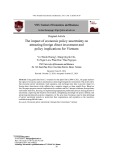
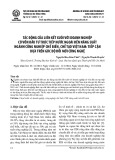
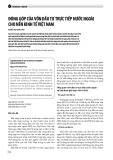

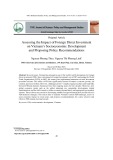
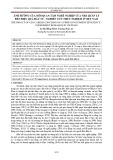










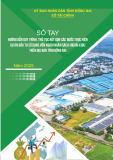
![20 câu hỏi Quản lý dự án phần mềm có đáp án [mới nhất]](https://cdn.tailieu.vn/images/document/thumbnail/2025/20251003/hieu2004haha@gmail.com/135x160/78791759734259.jpg)


![Tài liệu Quản lý dự án: Kiến thức nền tảng toàn diện [chuẩn SEO]](https://cdn.tailieu.vn/images/document/thumbnail/2025/20250910/kimphuong1001/135x160/92631757496585.jpg)



